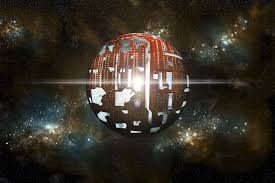
Could We Build a Dyson Sphere? Theoretical Science Unpacked
Imagine harnessing the full energy of our Sun—every photon, every watt, captured and used. That’s the staggering premise behind the concept of a Dyson Sphere, a theoretical megastructure that could encircle a star to collect its energy output. Popularized by science fiction and grounded in astrophysical theory, the Dyson Sphere remains one of the most ambitious ideas ever conceived by humanity.
But how feasible is it really? Could we, with enough time and technology, actually build one? Let’s unpack the science, the challenges, and what such a project would mean for our place in the cosmos.
What Is a Dyson Sphere?
The term “Dyson Sphere” comes from theoretical physicist Freeman Dyson, who in 1960 suggested that a technologically advanced civilization could construct a massive structure around its star to capture solar energy on a scale far beyond anything Earth-bound.
However, Dyson never envisioned a solid, rigid sphere like the kind seen in movies. That would be structurally impossible with known materials. Instead, his idea was more of a Dyson swarm—a massive array of satellites or solar collectors orbiting the Sun in a dense formation, working together to harvest energy.
Variants of the concept include:
-
Dyson Swarm – Thousands or millions of independent solar panels orbiting in a coordinated pattern.
-
Dyson Ring – A partial structure, often a conceptual stepping stone to larger designs.
-
Dyson Bubble – A shell of statites (stationary satellites) held in place by radiation pressure.
-
Dyson Shell – The sci-fi version—a rigid, hollow sphere completely surrounding a star. Currently considered physically unfeasible.
Why Build a Dyson Sphere?
The simple answer: energy.
Our current civilization consumes about 20 terawatts of power. That’s minuscule compared to the Sun’s output—around 400 septillion watts. A Dyson Sphere could provide a virtually unlimited power source, fueling technologies like:
-
Interstellar travel
-
Terraforming planets
-
Advanced artificial intelligence
-
Mega-scale manufacturing
-
Post-scarcity economics
In the framework known as the Kardashev Scale, which measures a civilization’s technological advancement based on energy usage, a Dyson Sphere would mark the leap from a Type I civilization (planetary) to Type II (stellar).
Could We Actually Build One?
1. Material Requirements
To build even a basic Dyson Swarm, we’d need unimaginable amounts of raw materials. Some estimates suggest dismantling an entire planet—like Mercury—just to get the metals needed for millions of solar collectors.
We’d also need:
-
Self-replicating robots to build and maintain the swarm
-
Vast interplanetary mining operations
-
Autonomous logistics and energy distribution networks
2. Engineering and Logistics
Constructing and coordinating a swarm of millions of autonomous satellites orbiting the Sun is an engineering nightmare. Avoiding collisions, maintaining synchronization, and dealing with solar flares are just a few of the problems we’d face.
We’d need:
-
Advanced AI for coordination
-
Fusion-powered propulsion systems
-
Space-based manufacturing facilities
3. Timeframe
Even if we started today, building a functional Dyson Swarm could take centuries—possibly thousands of years. But as exponential technologies like AI, robotics, and 3D printing advance, the timeline may shrink.
4. Political and Ethical Challenges
Who controls the Dyson Sphere? Who decides how the energy is used? Would it create vast inequality, or could it usher in a utopian post-energy-scarcity society?
The social and ethical dimensions are as significant as the scientific ones.
Are There Signs of Dyson Spheres Out There?
Interestingly, astronomers have speculated that advanced alien civilizations might leave behind detectable signatures—like the heat or light distortion caused by a Dyson Sphere.
In 2015, a mysterious star known as KIC 8462852 (aka Tabby’s Star) drew attention when its brightness dipped erratically. Some hypothesized that an alien megastructure might be responsible, though later studies suggested dust or comets as more likely causes.
Still, searching for Dyson-like phenomena is now a part of the growing field of astroengineering SETI (Search for Extraterrestrial Intelligence).
What Would It Mean for Humanity?
Building a Dyson Sphere—or even starting the process—would represent a tipping point in our species’ development. It would mean:
-
We’ve become a spacefaring civilization
-
We’ve solved the problem of sustainable energy
-
We’ve expanded our thinking from planetary to interstellar scale
Such a project would not only reshape technology but redefine culture, philosophy, and our relationship with the universe.
The Road to Dyson
We’re nowhere near Dyson Sphere-level engineering today. But each step we take toward space infrastructure—like solar satellites, asteroid mining, or moon bases—brings us a little closer.
Milestones along the way might include:
-
Orbital solar farms beaming energy to Earth
-
Massive solar arrays on the Moon or Mars
-
Autonomous robotic miners extracting resources in the asteroid belt
Each of these is a building block in what could eventually become a Dyson Swarm.
Final Thoughts
A Dyson Sphere may still sound like science fiction, but the ideas behind it are rooted in real science and real possibility. As our technological capabilities grow, so too does the scope of our ambition. Whether in 500 years or 5,000, humanity might one day harness the full power of the Sun—not through magic, but through engineering.
And when that happens, we’ll know we’ve truly stepped into the cosmic age.
Tags: Dyson Sphere, megastructure, space engineering, energy future, Kardashev Scale, interstellar civilization, theoretical science, space technology.
